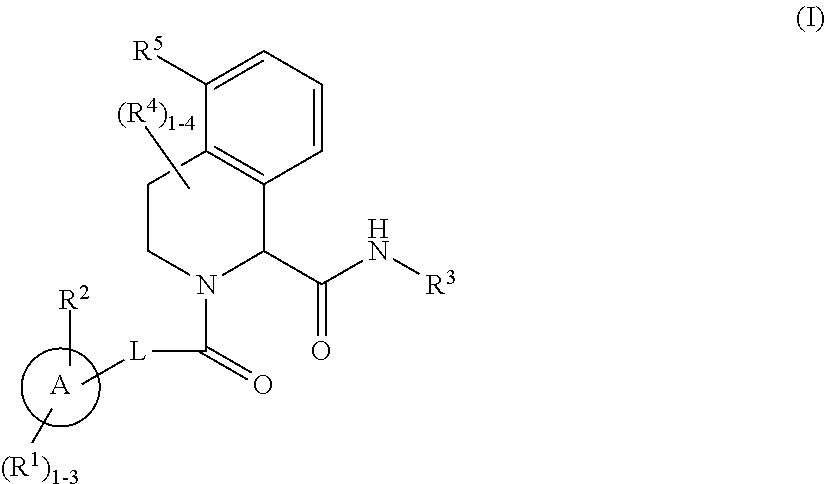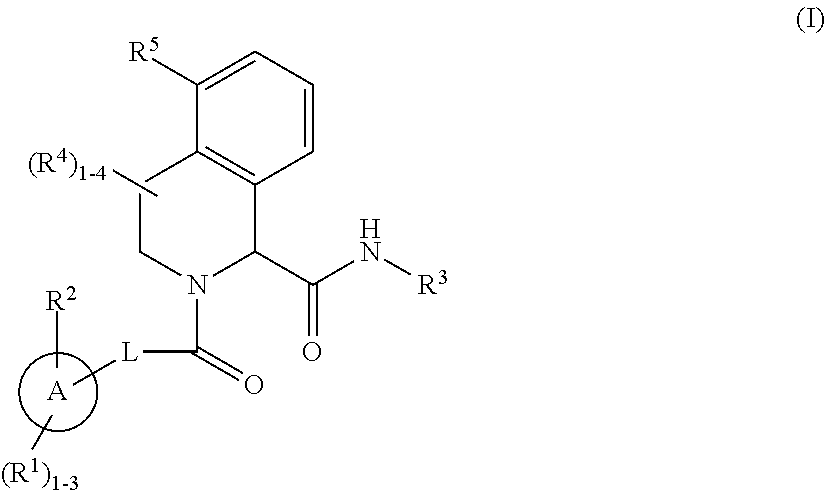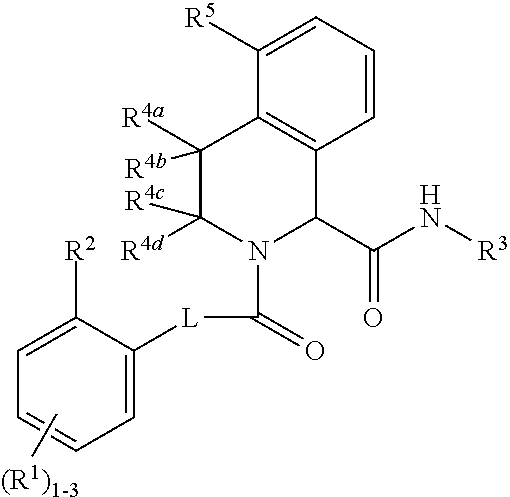Substituted tetrahydroisoquinoline compounds as factor xia inhibitors
a technology of substituting tetrahydroisoquinoline and factor xia inhibitor, which is applied in the field of new products, can solve the problems of limited use of thq compounds
- Summary
- Abstract
- Description
- Claims
- Application Information
AI Technical Summary
Benefits of technology
Problems solved by technology
Method used
Image
Examples
example 1
(E)-4-(2-(3-(5-chloro-2-(1H-tetrazol-1-yl)phenyl)acryloyl)-5-cyano-1,2,3,4-tetrahydroisoquinoline-1-carboxamido)benzoic acid
[0471]
[0472]Intermediate 20 (0.05 g, 0.320 mmol), Intermediate 6 (0.065 g, 0.320 mmol) and Intermediate 2 (0.080 g, 0.320 mmol) were heated in EtOH (3 mL) to reflux for 24 h. The reaction mixture cooled to rt and was concentrated, followed by treatment with TFA / DCM to give the desired product as a white solid (0.0065 g, 3.6%). 1H NMR (400 MHz, DMSO-d6) δ 12.65 (1H, br.s.), 10.79 (1H, s), 9.79 (1H, s), 8.38 (1H, d, J=1.8 Hz), 7.78-7.90 (3H, m), 7.66-7.76 (5H, m), 7.53 (1H, d, J=15.4 Hz), 7.43 (1H, t, J=7.8 Hz), 6.91 (1H, d, J=15.2 Hz), 5.87 (1H, s), 4.20-4.35 (1H, m), 4.01-4.12 (1H, m), 3.03-3.13 (1H, m), 2.82-3.00 (1H, m) ppm. MS (ESI) m / z: 553.8 (M+H)+. Analytical HPLC: RT=8.51 min.
example 2
(E)-4-(2-(3-(5-chloro-2-(1H-tetrazol-1-yl)phenyl)acryloyl)-5-(methoxycarbonyl)-1,2,3,4-tetrahydroisoquinoline-1-carboxamido)benzoic acid
[0473]
[0474]Intermediate 21 (0.450 g, 1.797 mmol), Intermediate 6 (0.365 g, 1.797 mmol) and Intermediate 2 (0.34 g, 1.797 mmol) were heated in EtOH (3 mL) to reflux for 24 h. The reaction mixture cooled to rt and was concentrated, followed by treatment with TFA / DCM to give the desired product as a white solid (0.0065 g, 3.6%). 1H NMR (400 MHz, MeOD) δ 9.54 (1H, s), 8.21 (1H, d, J=2.27 Hz), 7.96 (2H, d, J=8.59 Hz), 7.89 (1H, d, J=7.83 Hz), 7.68-7.77 (1H, m), 7.60-7.68 (3H, m), 7.55-7.60 (1H, m), 7.33-7.45 (2H, m), 7.17-7.29 (1H, d, J=15.4 Hz), 5.91 (1H, s), 4.31 (1H, ddd, J=12.38, 5.43, 5.18 Hz), 3.93 (3H, s), 3.81 (1H, ddd, J=12.63, 8.97, 4.17 Hz), 3.56-3.68 (1H, m), 3.44-3.57 (1H, m) ppm. MS (ESI) m / z: 586.9 (M+H)+. Analytical HPLC: RT=8.52 min.
example 3
(E)-4-(2-(3-(5-Chloro-2-(1H-tetrazol-1-yl)phenyl)acryloyl)-5-(2-methoxyethylcarbamoyl)-1,2,3,4-tetrahydroisoquinoline-1-carboxamido)benzoic acid
[0475]
[0476]3A: (E)-1-(4-(tert-Butoxycarbonyl)phenylcarbamoyl)-2-(3-(5-chloro-2-(1H-tetrazol-1-yl)phenyl)acryloyl)-1,2,3,4-tetrahydroisoquinoline-5-carboxylic acid: To the tert-butyl ester from Example 2 (0.63 g, 0.980 mmol) in 1:1 THF / H2O (20 mL) was added LiOH (0.164 g, 3.92 mmol). Quenched the reaction after 3 h and obtained 0.6 g mixture of acid and starting ester. The mixture was hydrolized again and after 3 h, adjusted pH to 5 with dilute HCl and extracted with EtOAc (2×20 mL). The organic layer was washed with brine (10 mL) and dried (MgSO4) to afford 0.22 g of 3A. MS (ESI) m / z: 629.0 (M+H)+.
[0477]3B: (E)-tert-Butyl 4-(2-(3-(5-chloro-2-(1H-tetrazol-1-yl)phenyl)acryloyl)-5-(2-methoxyethylcarbamoyl)-1,2,3,4-tetrahydroisoquinoline-1-carboxamido)benzoate: To 3A (46 mg, 0.073 mmol), 2-methoxyethanamine (5.49 mg, 0.073 mmol), BOP (32.3 mg, ...
PUM
 Login to View More
Login to View More Abstract
Description
Claims
Application Information
 Login to View More
Login to View More - R&D
- Intellectual Property
- Life Sciences
- Materials
- Tech Scout
- Unparalleled Data Quality
- Higher Quality Content
- 60% Fewer Hallucinations
Browse by: Latest US Patents, China's latest patents, Technical Efficacy Thesaurus, Application Domain, Technology Topic, Popular Technical Reports.
© 2025 PatSnap. All rights reserved.Legal|Privacy policy|Modern Slavery Act Transparency Statement|Sitemap|About US| Contact US: help@patsnap.com



